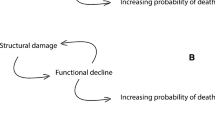Abstract
Programmed aging refers to the idea that senescence in humans and other organisms is purposely caused by evolved biological mechanisms to obtain an evolutionary advantage. Until recently, programmed aging was considered theoretically impossible because of the mechanics of the evolution process, and medical research was based on the idea that aging was not programmed. Theorists struggled for more than a century in efforts to develop non-programmed theories that fit observations, without obtaining a consensus supporting any non-programmed theory. Empirical evidence of programmed lifespan limitations continued to accumulate. More recently, developments, especially in our understanding of biological inheritance, have exposed major issues and complexities regarding the process of evolution, some of which explicitly enable programmed aging of mammals. Consequently, science-based opposition to programmed aging has dramatically declined. This progression has major implications for medical research, because the theories suggest that very different biological mechanisms are ultimately responsible for highly age-related diseases that now represent most research efforts and health costs. Most particularly, programmed theories suggest that aging per se is a treatable condition and suggest a second path toward treating and preventing age-related diseases that can be exploited in addition to the traditional disease-specific approaches. The theories also make predictions regarding the nature of biological aging mechanisms and therefore suggest research directions. This article discusses developments of evolutionary mechanics, the consequent programmed aging theories, and logical inferences concerning biological aging mechanisms. It concludes that major medical research organizations cannot afford to ignore programmed aging concepts in assigning research resources and directions.
Similar content being viewed by others
References
Olshansky, S., Hayflick, L., and Carnes, B. (2002) No truth to the fountain of youth, Sci. Am. (reprinted July 2004, 14).
Weismann, A. (1882) Uber die Dauer des Lebens, Fischer, Jena.
Wynne-Edwards, V. (1962) Animal Dispersion in Relation to Social Behaviour, Oliver & Boyd, Edinburgh.
Hamilton, W. (1963) The evolution of altruistic behavior, Am. Naturalist, 97, 354–356.
Travis, J. (2004) The evolution of programmed death in a spatially structured population, J. Gerontol., 59, 301–305.
Dawkins, R. (1986) The Selfish Gene, Oxford University Press.
Goldsmith, T. (2008) Aging, evolvability, and the individual benefit requirement; medical implications of aging theory controversies, J. Theor. Biol., 252, 764–768.
Goldsmith, T. (2014) The Evolution of Aging, 3rd Edn., Azinet Press, Annapolis.
Skulachev, V. (1997) Aging is a specific biological function rather than the result of a disorder in complex living systems: biochemical evidence in support of Weismann’s hypothesis, Biochemistry (Moscow), 62, 1191–1195.
Mittledorf, J. (2006) Chaotic population dynamics and the evolution of ageing, Evol. Ecol. Res., 8, 561–574.
Libertini, G. (1988) An adaptive theory of increasing mortality with increasing chronological age in populations in the wild, J. Theor. Biol., 132, 145–162.
Williams, G. (1966) Adaptation and Natural Selection: A Critique of Some Current Evolutionary Thought, Princeton.
Medawar, P. (1952) An Unsolved Problem of Biology, H. K. Lewis & Co., London.
Williams, G. (1957) Pleiotropy, natural selection and the evolution of senescence, Evolution, 11, 398–411.
Kirkwood, T., and Holliday, F. (1979) The evolution of ageing and longevity, Proc. R. Soc. Lond. B, 205, 531–546.
Goldsmith, T. (2013) Arguments against non-programmed aging theories, Biochemistry (Moscow), 78, 971–978.
Loison, A., Fiesta-Bianchet, M., Gaillard, J., Jorgenson, J., and Jullien, J. (1999) Age-specific survival in five populations of ungulates: evidence of senescence, Ecology, 80, 2539–2554.
Wodinsky, J. (1977) Hormonal inhibition of feeding and death in octopus: control by optic gland secretion, Science, 198, 948–951.
Apfeld, J., and Kenyon, C. (1999) Regulation of lifespan by sensory perception in Caenorhabditis elegans, Nature, 402, 804–809.
Bennett, J. T., Boehlert, G. W., and Turekian, K. K. (1982) Confirmation on longevity in Sebastes diploproa (Pisces: Scorpaenidae) from 210Pb/226Ra measurements in otoliths, Marit. Biol., 71, 209–215.
Bateson, W., Saunders, E., and Punnett, R. (1904) Report II. Experimental studies in the physiology of heredity, Rep. Evol. Com. R Soc., 2, 1–154.
Valdez, R., and Krausman, P. (1999) Mountain Sheep of North America, The University of Arizona Press, Tucson.
Wagner, C., and Altenberg, L. (1996) Perspective: complex adaptations and the evolution of evolvability, Evolution, 50, 3.
Kirkwood, T., and Melov, S. (2011) On the programmed/non-programmed nature of ageing within the life history, Curr. Biol., 21, R701–R707.
Skulachev, V. (2011) Aging as a particular case of phenoptosis, the programmed death of an organism (A response to Kirkwood–Melov “On the programmed/non-programmed nature of aging within the life history”), Aging (Albany N. Y.), 3, 1120–1123.
Goldsmith, T. (2016) Emerging programmed aging mechanisms and their medical implications, Med. Hypotheses, 86, 92–96.
Weindruch, R., Walford, R., Fligiel, S., and Guthrie, D. (1986) The retardation of aging in mice by dietary restriction: longevity, cancer, immunity and lifetime energy intake, J. Nutr., 116, 641–654.
American Academy of Anti-Aging Medicine (A4M), website, 6/2016.
Darwin, C. (1872) The Origin of Species, 6th Edn., Murray, London.
Author information
Authors and Affiliations
Corresponding author
Additional information
Published in Russian in Biokhimiya, 2016, Vol. 81, No. 12, pp. 1675–1684.
Rights and permissions
About this article
Cite this article
Goldsmith, T.C. Evolution of aging theories: Why modern programmed aging concepts are transforming medical research. Biochemistry Moscow 81, 1406–1412 (2016). https://doi.org/10.1134/S0006297916120026
Received:
Published:
Issue Date:
DOI: https://doi.org/10.1134/S0006297916120026



